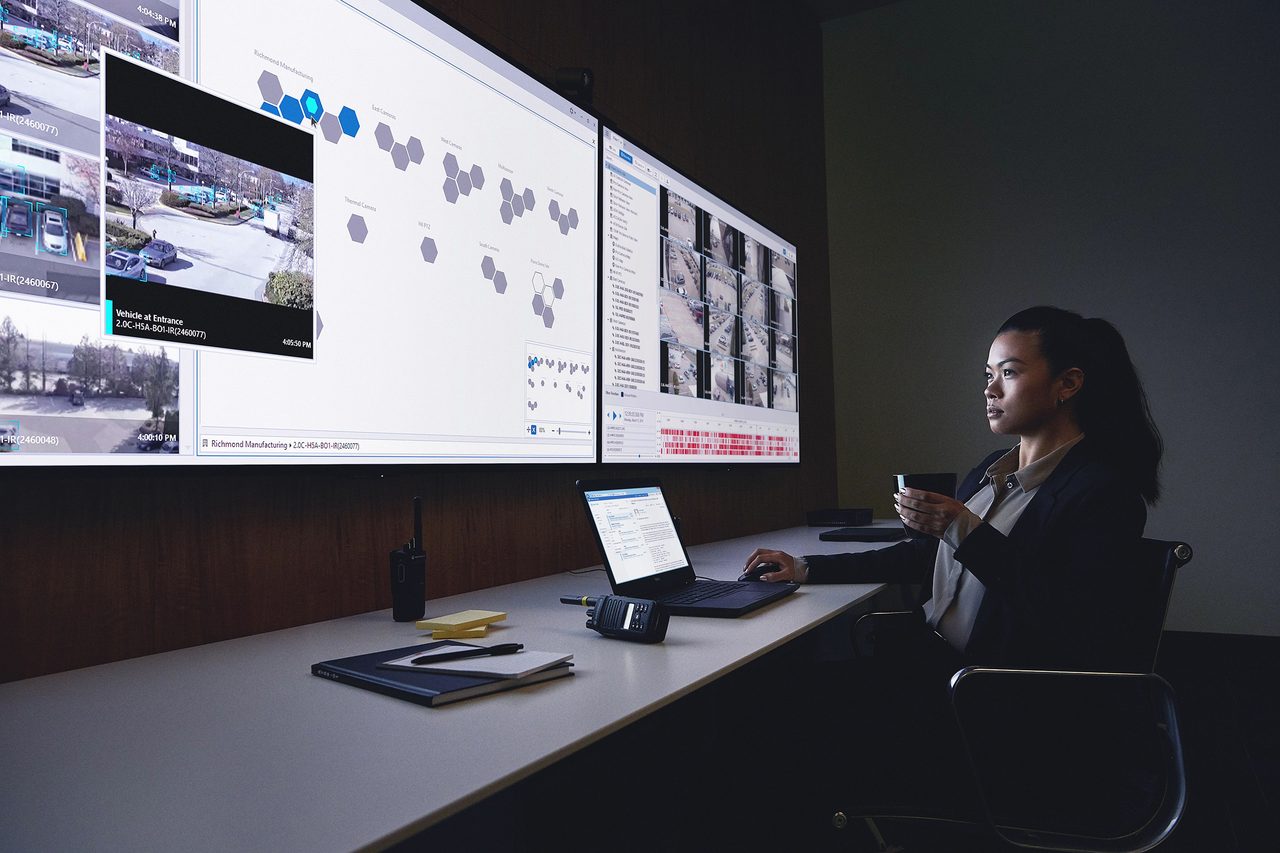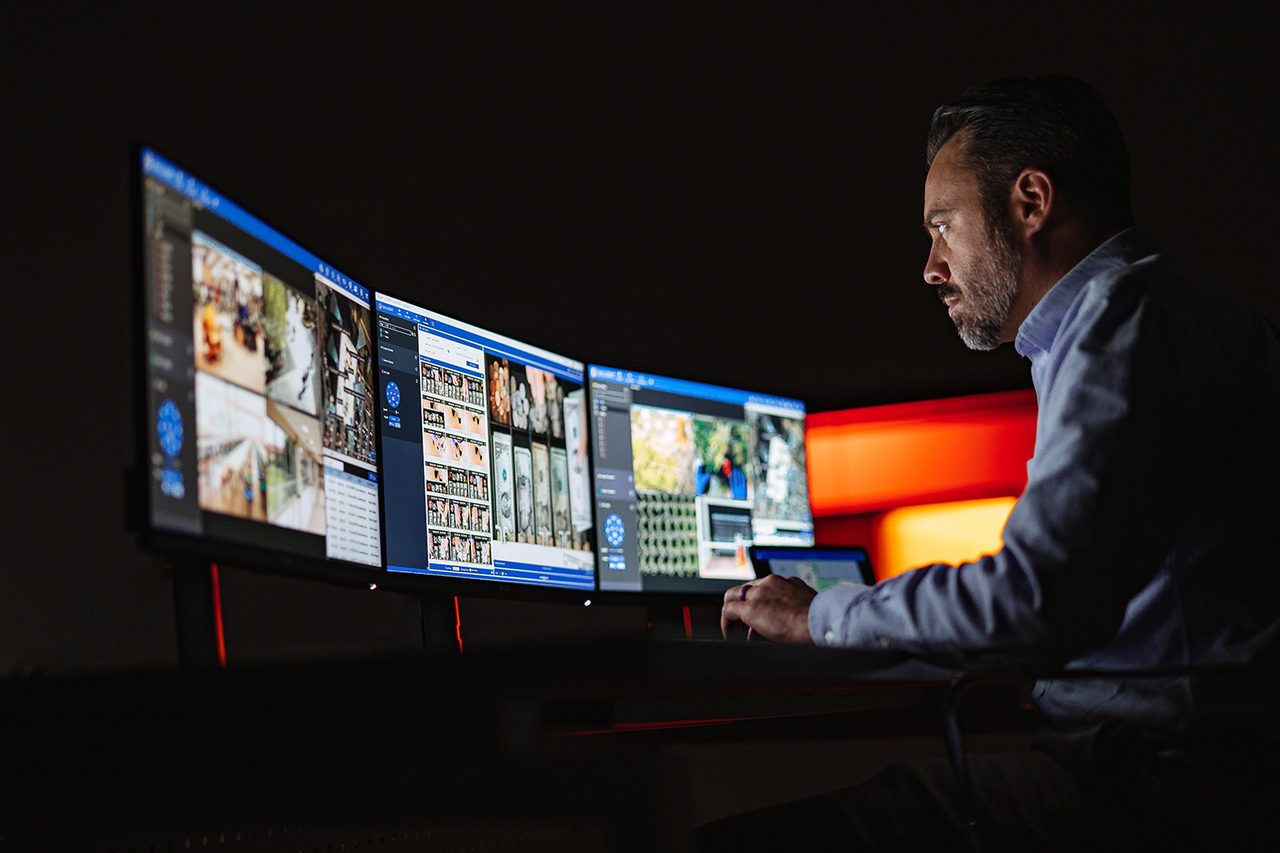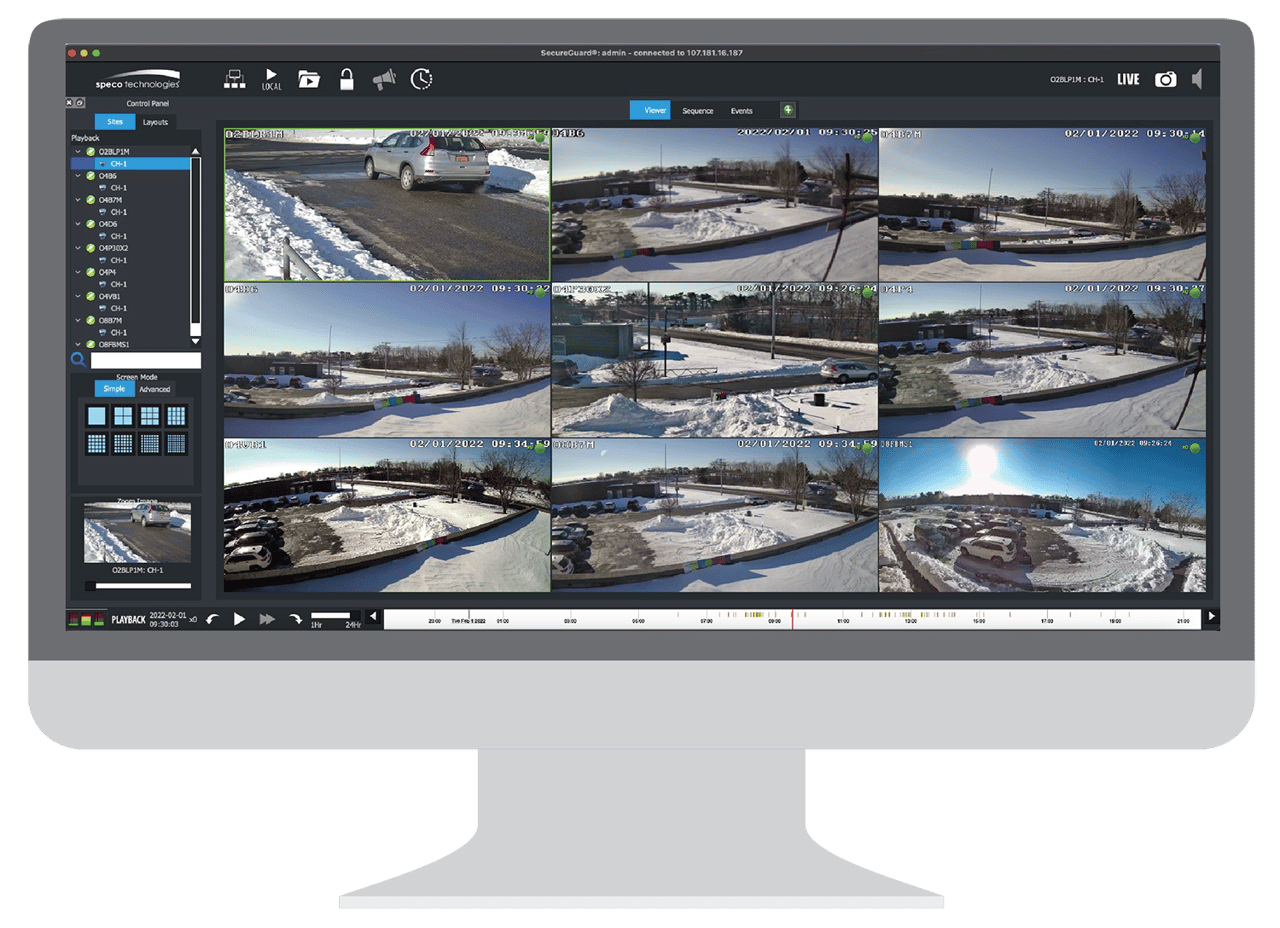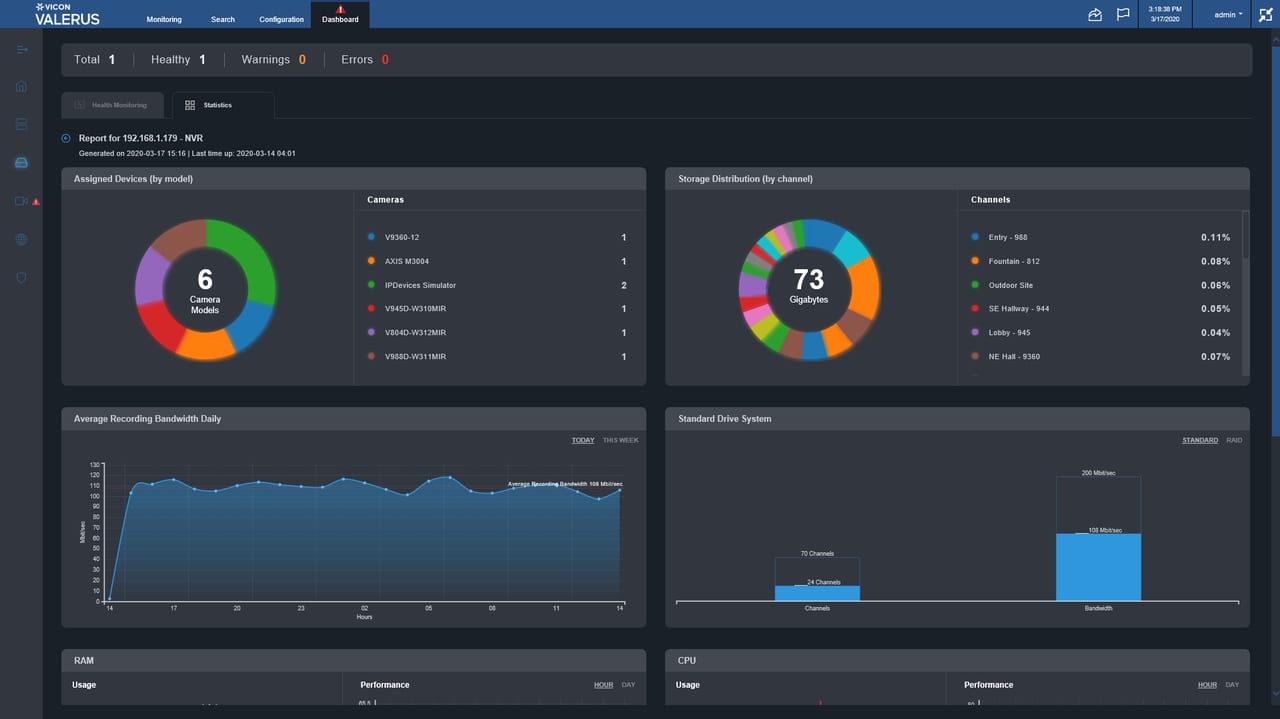// Video Surveillance

Deconstructing AI
for VMS
Motorola Solutions’ Avigilon Control Center uses sophisticated AI to learn and detect unusual activity, allowing security operators to make faster, more informed decisions.
IMAGE COURTESY OF motorola Solutions
Deconstructing AI for VMS
Security experts weigh in on the past, present and future of artificial intelligence in video management systems.
By Anna Boudinot, SDM Contributing Writer
Artificial Intelligence in video surveillance applications has moved out of the buzzword stage into reality, with security manufacturers touting AI functionality in a slew of devices.
When it comes to video management systems (VMS), artificial intelligence bolsters facial recognition, perimeter detection, license plate recognition (LPR), people counting, and more.
But do end users really utilize these capabilities? We engaged industry experts in a discussion on the future — and present — of AI in VMS.
Efficiency, Accuracy — Then, Acceptance
Video analytics are software applications that are programmed to create descriptions of what is occurring in a video scene and trigger a specific action — such as sending an alert — based on a particular description. Bringing AI into analytics gives the software the power to make sense of the data it collects over time and change its “behavior” without being programmed to do so. For example, motion detection without AI may send the same false alarm every time a racoon breaches a perimeter fence. Motion detection with AI has the ability to learn from thefalse alarms and stop sending them when the racoon shows up again.
In the beginning, artificial intelligence (AI) features and analytics generated a lot of interest with the exciting opportunities they presented. But it was all talk, no show at first.
“AI features and analytics were difficult to monetize in the beginning because of the dynamics of the market at that time,” recalls Leo Levit, chairman of the Steering Committee, ONVIF, San Ramon, Calif. “As the market and technology has matured, the promised functionalities of artificial intelligence have [been] used by customers in a variety of ways that many might not [have previously associated] with AI.” He cites examples of AI being used to optimize video quality or ensure that metadata is more efficiently tagged. “In many cases, AI is running behind the scenes to improve VMS features and make the jobs of operators easier.”
While camera technology is getting smarter and offering strong analytics at the edge, the accuracy of AI-based solutions and algorithms is increasing, making them more attractive to security operators. Bret McGowan, senior vice president, sales and marketing at Vicon Industries, Hauppauge, N.Y., notes, “Better accuracy is something users are very receptive to. As a result, customers are more accepting of the concept of analytics, and they are even asking for this capability.”
Customization for Customers Both Large & Small
Customers are also asking for customization of analytics-based solutions, says Fabio Marti, vice president of marketing for Munich, Germany-based Azena. He gives examples of customizations that run the gamut from flare detection for pumpjacks in oil and gas field operations, to line crossing analytics to ward off seabirds diving into pools of farmed salmon, to queue detection to measure the length of lines at different sporting event concession stands and direct fans to shorter lines.
Smaller customers can look forward to taking advantage of AI without yesterday’s hefty price tag, predicts Laurent Villeneuve, product marketing manager, Genetec Inc., Montreal. “Because complex video analytics still require very powerful servers for adequate data processing, deploying analytics at an enterprise level isn’t always practical,” he explains. “As we move into 2022, we believe video analytics applications will mature in ways that make them easier to use and more economical to deploy at scale. This evolution will be made possible by vendors who focus on hardware resource efficiency and offer more granular controls for running analytics at certain intervals or schedules, instead of continuously.”
VMS & Data Protection
A VMS, and the systems with which it integrates, constantly generate data. Protecting that data for forensic and recovery purposes goes beyond video data — it includes the settings and logic behind the scenes. We asked experts how integrators and end users can ensure the highest levels of data protection for a VMS platform.
“Have a database backup schedule in place and have backups saved in a location that is not on the operating system drive. It is also recommended to perform validation after recovering a database and monthly, as maintenance. And as an extra layer of protection, have a manually backed-up stable database saved on a USB. This should be updated whenever a new version of the VMS is installed or when any additions or changes have been made to the installation. A passing validation should be confirmed as well before manually backing up.” — Timothy J. Dickson, vice president of marketing, Speco Technologies, Amityville, N.Y.
“An underestimated functionality of a VMS is the ability to provide visibility over time, insights, and tracking of all data operations within the system. Encrypting video and masking people to safeguard privacy is great, and it’s something you'll likely activate upon the initial deployment. But the way the system is deployed today won’t stand the test of time. Keeping track of everything throughout the system’s lifecycle is just as important. [End users] should ensure their maintenance and auditing strategy is rock solid.” — Laurent Villeneuve, Genetec.
“Customers should focus on vendors that make data protection a core tenet of their software design and engineering, drawing on current, industry-accepted cybersecurity protocols. This includes providing regular software updates to maintain the most current versions of software and applicable security patches. Most importantly, vendors should be transparent regarding potential security vulnerabilities and proactively communicate with customers to provide actionable steps for mitigation in the event of a discovered vulnerability or cyber-breach.” — Fabio Marti, Azena.
//
Human-Centered Design
In the never-ending advancement of technology, operators are tasked with processing more and more data. Manufacturers and software developers are rising to the challenge of making AI features easier to use and adopt.
Alex Asnovich, global head of marketing, video security, access control and critical communications, shares the approach taken by Chicago’s Motorola Solutions: “The use of AI in our products is designed to help security operators stay more focused, agile and efficient at their jobs by bringing the most important events to their attention. This allows them to make better, faster, more informed decisions and frees them up to do what they do best, which is verifying and taking swift action on critical events. These capabilities will continue to advance as we seek to offer more products and integrations that make watching live video [more] obsolete. However, the role of human-centered design remains core to the use of AI in our applications, now and in the future.”
Clients get a greater ROI from AI functionality if it benefits them across departments, meeting both security and business needs. Retail settings are a classic case-in-point for AI.
IMAGE COURTESY OF SALIENT

Viewing AI as a complement to human-operated security rather than a replacement strengthens security systems and serves as a selling point for integrators looking to persuade their customers on AI.
Ivan Golian, vice president of technology at Netronix Integration, San Jose, Calif., tells his customers, “When implemented correctly, AI can help subsidize the human element and enhance operators’ ability to respond to qualified alerts.”
Case in Point: Retail
Clients get a greater ROI from AI functionality if it benefits them across departments, meeting both security and business needs. Chris Garner, senior product manager of Salient Systems, Austin, Texas, uses retail as an example:
“The retail market provides a great example of utilizing AI to address both these needs. To address security concerns, a retailer can deploy facial detection or gun detection systems to alert employees of known shoplifters or other potential threats. To address business needs, AI-enabled video analytics can monitor the length of the cash register queue to help understand how many people are waiting to be checked out. Further, retailers can look at heat mapping to understand traffic patterns and optimize product placement in the store.”
//
The AI Pitch
Integrators poring over spec sheets and absorbing sales materials from manufacturers sometimes serve as interpreters, translating feature sets into solutions their customers will actually use.
“The AI pitch is a difficult one,” Golian says. “You can’t pitch something without finding out if there is a need or pain point that needs to be addressed. Is their HR struggling to provide accurate information regarding contact tracing during the pandemic? Has the SOC/security personnel had a staffing issue that would require a sizeable reduction in false alarms on the ACS side to prevent unnecessary dispatch?”
AI-driven analytics can provide solutions to these specific issues.
“Most end users do not know what AI is or how it can help them in their information requirements,” adds Paul Georges, president of Underwriters Security Controls Inc. in Markham, ON. “We use AI as a solution for specific needs, and every user’s needs are unique.”
Jim DeStefano, senior vice president at Unlimited Technology, Chester Springs, Pa., agrees. “It’s about listening to the customer, understanding what their needs are, and understanding how they operate,” he says. “It’s incumbent upon integrators to understand what AI can do. AI isn’t applicable to everybody but it’s on us to find the right solution for our customers and help them understand those solutions.”
When it comes to video management systems (VMS), artificial intelligence bolsters facial recognition, perimeter detection, license plate recognition (LPR), people counting, and more.
IMAGE COURTESY OF SPECO

Smart Features Don’t Always Mean AI
AI does not need to be standard issue. “Not all video management and analytics products can or should use AI-based features,” says Genetec’s Laurent Villeneuve.
Cutting-edge video management systems on the market today offer powerful, intelligent features even without AI. For example, open platform VMS, when integrated with smart video analytics, provide fast and efficient search capabilities.
To delineate smart features that don’t require AI, here is a list of examples from Jennifer Hones, manager, Key Account Team, Milestone Systems, Lake Oswego, Ore.:
- Create cases and organize all investigative video in a single container to efficiently review video from within the VMS user interface.
- Simultaneously display objects that have appeared at different times within the video, making for faster investigations. Milestone’s patented VIDEO SYNOPSIS offers this feature.
- Forensically pinpoint areas with most occupancy (such as the number of people in a specific area) for greater scene understanding and insights.
//
End Users’ Perspective
Is it possible for manufacturers to alleviate some of this burden by making AI features of VMS easier for end users to adopt? The answer is yes — for those who can understand the perspective of the end user.
“When manufacturers can explain why AI is important as a concept and help me understand the benefits for my customers, my sell to the customer isn’t as hard because the customer gets the ‘why’ and they realize they need it,” DeStefano explains.
Manufacturers should also remember there is typically more than one person on the end user side making the purchase decision, Golian points out.
“While funding may come from the C-level, and compliance comes from HR or legal, the vetting of said technology usually consists of the physical security team as well as the InfoSec team. The more simply a manufacturer can address the potential concerns for each of these teams, the easier the process for all parties involved. Showing how the product adds ROI by assisting in the creation of a business value assessment puts real numbers on paper that all can understand.”
Another key factor of adoption is ease of use. Georges’ wish list includes, “Features available on the dashboard and the camera set-up screen, simple drag-and-drop features to specific areas of view, and select search features (e.g., type/color of vehicle, type of movement, size of vehicle.)”
While camera technology is getting smarter and offering strong analytics at the edge, the accuracy of AI-based solutions and algorithms is increasing, making them more attractive to security operators.
IMAGE COURTESY OF VICON

Finally, end users who trust manufacturers will be more willing to adopt AI, says Golian, though it may take time. “AI in today’s VMS marketplace is something of an enigma, both venerated and feared. It can be arduous to understand and even more challenging to explain. How can anyone trust a system if they don’t truly understand how it works?” he asks. “Don’t get me wrong, I am not fully qualified to explain the inner workings of a Rolls-Royce Trent 1000 turbofan, but I get on an aircraft anyway. There have been decades of research and development that create a level of confidence there — confidence that the vast majority of the AI industry has yet to achieve.”
After years of being little more than a buzzword, AI is catching on, thanks to greater accuracy, affordability, and options for customization in security applications. As manufacturers focus on human-centered design and seek other ways to make AI in VMS appealing to security operators, it seems “the AI pitch” won’t be such a tough sell in the future. Until then, building trust — among manufacturers, integrators, end users, and within the VMS platforms themselves — will go a long way to make AI mainstream. SDM

